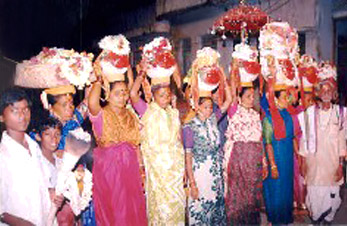Colorful festivals, exquisite handiworks, dance and music forms have made the culture of Berhampur exuberant yet exclusive and alluring. Thus its cultural exuberance is depicted in its plethora of handicrafts of Berhampur. Berhampur is called Silk city with silk fabrics of Berhampur dominating the market. Handiworks of other places also are easily available. Brass work of Ganjam, coir mats of Gopalpur and the superb horn works of Paralakhemundi can be secured from here. Exquisite carpets from Chandragiri, threaded by the refugees from Tibet, are the specialties.
 Festivals, an integral part of the culture of Berhampur, add spice to the lives of the localites. Shiva Ratri, Makar Mela, Khambeswari Yatra, Buda, Thakurani Yatra, Tara tarini Mela, Car Festival, Ganesh Puja, Dussera, Budha Kandu Yatra deserve special mentioning. This was the time when the people enjoy life to their fullest forgetting all the hassles and problems of the day-to-day living.
Festivals, an integral part of the culture of Berhampur, add spice to the lives of the localites. Shiva Ratri, Makar Mela, Khambeswari Yatra, Buda, Thakurani Yatra, Tara tarini Mela, Car Festival, Ganesh Puja, Dussera, Budha Kandu Yatra deserve special mentioning. This was the time when the people enjoy life to their fullest forgetting all the hassles and problems of the day-to-day living.
The joyous mood of the people gets more fascinated with dancing and singing. In other words, dance and music are key elements for depicting the true nature of the culture of Berhampur. To imitate the animals in dance forms is popular amongst the tribal communities. Following this trend, tiger dancing is prevalent especially during Thakurani Jatra, a popular theater form.
Culinary dishes also show how enriched the culture of Berhampur is. Food patterns are similar to that of neighboring states like West Bengal, Bihar etc. Staple food is rice. People also consume ample quantities of vegetables. Due to their propensity to religion majority of the people adapt to vegetarianism. In the entire state, pithas, a type of sweet delicacies is being eaten up especially during festivals. In normal time also pithas are prepared and consumed with great delight.
Orissa is a land of culture and heritage. It is best being reflected in its costumes and apparels. Heavy Berhampuri silks with their simple thin borders are specialties.
In Berhampur also people have followed the same style and tradition. Women of Orissa state deck up with wide ranging and fascination saris in different colors like black, white, yellow, and red. One will find these colors in the idol of Lord Jagannath of Orissa. In the beautiful motifs, which are embroidered in these sarees, are lotus, conch, wheel, etc. Here also there is resemblance with Lord Jagannath`s image. The pasapalli saris with black and white squares on them, is the imitation of chessboard. Cotton and tussar silk sarees also used. In order to improve their patterns golden threads are used. All these sarees weave a culture of exclusivity and elegance into the costumes of Orissa. Silver filigree jewellery is the style mark of the entire state, which gives a gentle stylish look to a person.



















